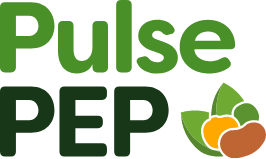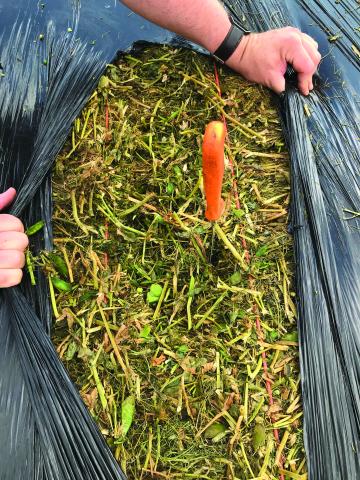Norfolk arable farmer, Charlie Davison, has rented parts of his 620-acre farm to carrot growers for many years. The crop provides a useful break from the winter wheat he grows for milling and seed on Game Farm in West Bilney, near Kings Lynn. However, although some of the carrots are lifted early and allow for drilling spring cereals, some are contracted to lift in late March, when there’s rarely the
time or conditions to prepare the land and drill the following cereal crop early enough in spring.
Catch crop
So, to avoid any fallow over the key growing months, Charlie set his mind to finding a fast-growing catch crop which could be sown late in the spring but be off the land by the end of summer. This would allow him plenty of time for autumn cultivations and for the all-important winter wheat to be drilled in the second half of September.
Hitting upon the idea of growing a crop of peas for haylage or hay, he says: “I found they were popular and did really well in the USA and New Zealand.”
And although he keeps no stock on the farm, he believed the crop would make a highly nutritious baled forage and would be tradeable to livestock producers.
Preserving legumes as forage
However, with no knowledge of how to process the crop at harvest, he contacted the PGRO (Processors and Growers Research Organisation). They referred him to Kelvin Cave Ltd, for their expertise in preserving legumes as forage, who put area manager, Michael Carpenter, on
to the job. Michael had worked with many producers in preserving legumes as wholecrop, and knew some of the same products and techniques could work with baled haylage.
The challenge was to harvest the crop when the pea itself was young and digestible but when the dry matter (DM) of the whole crop could reach around 75%. Failing this, a lower DM crop could be wrapped as haylage but the preferred option would be to hit the DM for hay and save the cost of wrapping.
In either case he knew the crop would have to be preserved to avoid any spoilage. He chose the additive, BaleSafe, which has an outstanding track record of preserving high dry matter forages.
“This preservative is formulated specifically for either wrapped haylage from 50-75% dry matter or
unwrapped hay of up to 25% moisture,” he explains. “It contains a blend of propionic and benzoic acids with human food preservatives which gives us complete confidence, when applied correctly, that treated bales won’t mould and spoil.”
Charlie took the decision to grow the peas as a catch crop for the first time in 2021. He chose a fast-growing forage variety called Magnus, which is described by its supplier, Limagrain, as ‘ready to harvest in 14 weeks’.
After the carrots were lifted at the end of March 2021, the pea cultivations followed.
“We incorporated the straw which is used to protect the carrots from frost, and then ploughed and prepared the seedbed, drilling the peas on 30 April,” he says.
Agronomy
The peas were drilled into light, sandy loam soils, at a seed rate of 125kg/ha. A 6m Kverneland tine air drill was used to place the seed into moisture, at a depth of 5cm, before the field was rolled.
The only treatment required was a pre-emergence herbicide to keep on top of weeds. No fungicides were needed, although bird control was used in one area alongside a wood to minimise pigeon damage.
The peas exceeded growth rate expectations and were in fact ready to harvest within less than 12 weeks. The decision was taken to cut them on 21 July, just after
flowering.
“Some of them looked like mangetouts at this stage, and within the pods some very small peas had started to form,” he says.
This seemed to be the perfect time, when the small peas were soft and would be easy for stock to digest and the haulm was not too lignified.
A key to the harvest was cutting the peas with a rape swather and leaving the crop spread wide. At a height of up to 1.2m, it would be too difficult to conventionally mow.
The crop was then left to dry and baled 10 days later. This allowed it to dry to a DM of 56% and baled and wrapped. A later-drilled crop was baled in early August, achieving a DM of 68%.
“In both cases, it looked as though the weather was breaking so the decision was taken to wrap, rather than attempt to dry down to hay,” says Michael.
The peas paved the way for the following crop which was the winter wheat variety, Zyatt, produced as seed for Frontier and drilled towards the end of September.
Nitrogen returned to the soil
This revealed the additional benefit of growing legumes which, in this case, were estimated to have returned 20-30kg/ha of nitrogen to the soil.
“This wheat is probably the best crop I have on the farm,” says Charlie. It also received a lower input of artificial nitrogen and the soil was reckoned to be in better condition thanks to the peas’ deep roots.
Yields and bale weights
With pea haylage bales weighing around 400kg and yields of 1.5t/acre there was plenty to sell from the 44 acres grown. And with an analysis of 19% protein and a metabolisable energy of 9.5MJ/kg DM it was clear it would make an exceptionally useful livestock forage.
Local farmers, including a Wagyu and a sheep producer were amongst the takers, and both have reported outstanding performance (see panel).
“My neighbour who keeps 800 ewes said the sheep go straight to it and are not interested in [grass] hay,” says Charlie. “It certainly has that sweet smell of high-quality forage and is clearly very palatable.”
The future
For the future he says he will grow more peas as long as he can develop a market for the haylage or hay. And with increasing numbers of livestock being encouraged on to the arable land of eastern England there could be a growing demand.
This year, he plans to increase his seed rate to 150kg/ha to push yields up further and may even attempt to double crop the peas. This would involve drilling a second pea crop in mid-July and harvesting in mid-September, which should double up on his profits and also boost the amount
of nitrogen fixed for the following crop of winter wheat.
Feeding pea haylage to Wagyu beef
When beef producer, Sarah Juggins, heard of the pea haylage her neighbour was making, she was
keen to try some bales for her small suckler herd of Wagyu and youngstock.
At 19% protein and with an ME of 9.5MJ/kg DM, she felt it would be the perfect counterbalance to
the brewers grains she fed to her stock.
Aside from the favourable composition, she is also keen to buy local and keep the food chain short,
and at Lower Farm, East Winch, she was just a stone’s throw from the Davisons’ farm.
Using some bales over winter from Charlie’s first crop, she said the quality was exceptional and the
haylage was ‘moist but never mouldy’.
“Since we started it’s become a key part of the diet,” she says. “The cattle just love it and there is
no wastage at all.”
If anything, she says, they are almost doing too well, but she is keen to achieve plenty of marbling
and see a good price for her beef from this premium breed.
Her high-end buyers would appear to bear this out, and include the Titchwell Manor Hotel, butchers,
J E Howard, whose shops include one on the Queen’s Sandringham Estate, and independent
coffee shop, Kofra Coffee, which also stocks rare breed and high-quality beef.
See article as it appeared in the original Kevin Cave KnowHow Newsletter below.



